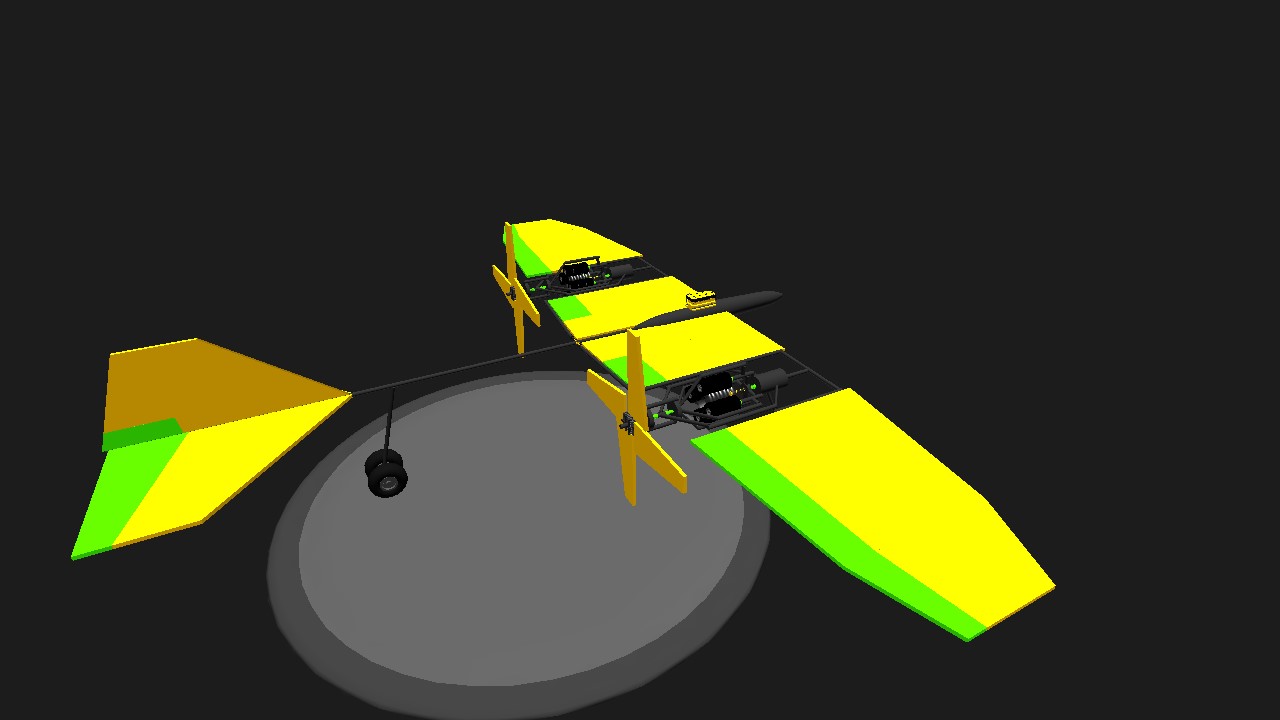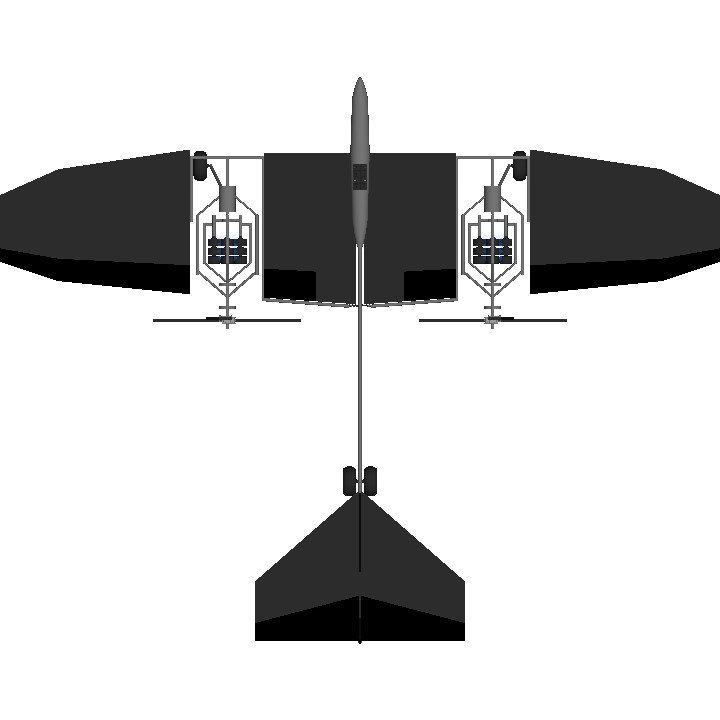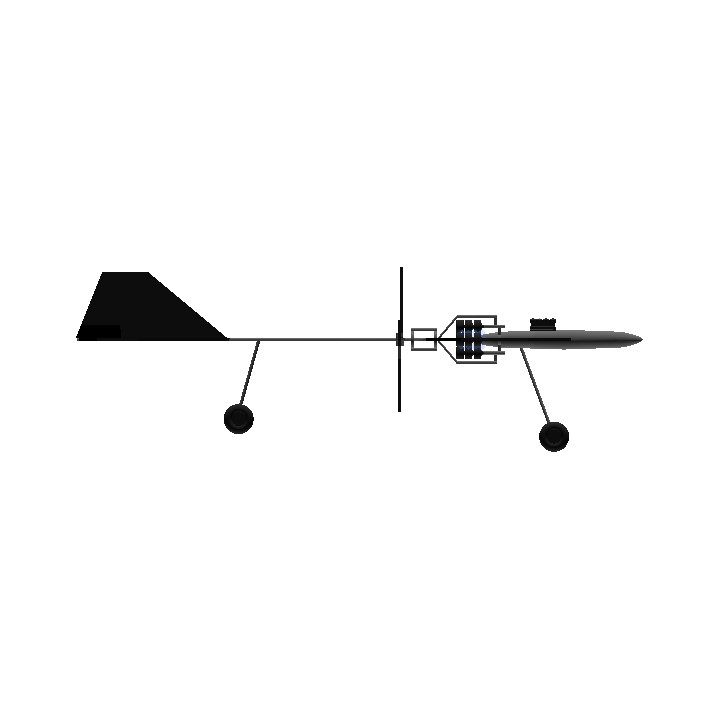Aircraft by/Credits to: DOX
Link to the original plane:https://www.simpleplanes.com/a/HlDxve/engine-to-prop-based-on-LimitedShelf568-plane
Aircraft with wheels as engines
and the result of my attempt to remake better
Here's the thing, as usual I was looking for some nice looking planes on the simple plane website and came across this plane by accident
An airplane with wheels as an engine looks great, and it actually feels very fresh to drive, so a process of transformation began...
Although only for one day
The results of the attempt and the next possible solutions are written here,
1. Thrust - First of all, where does the thrust of this plane come from? Although the original author's explanation is friction, but after trying to transform it, it seems that it is not friction, but may be the reaction force from the collision, which is the force that rebounds from the wheel contacting the object. , or reaction force, through the reaction force, let the engine push and connect the rotor and drive the rotation, so that the plane can really move forward, so it is not using the wheels to move forward, but like a normal aircraft, using the rotor and the air to move forward
Engine arrangement - the reaction force generated by the engine on a single aircraft is very strong, which can quickly accelerate the aircraft to about 100mph, but it is not controllable. It needs another engine to counter this reaction force to control it
Some details - the engine of the aircraft does not need to be allocated separately. It can also operate with one engine connected to all the wheels. The increase of the engine thrust will not directly increase the speed of the aircraft all the time. There is an increase limit. To do it the other way... just like I did to rebuild the engine...
When the aircraft engine is running, there will be jitter. Generally, this jitter will have an impact on the fuselage. Lightly, it will make the flight of the aircraft unstable, and in severe cases, it will make the aircraft disintegrate. It can be slowed down by adding shock absorbers. The original version uses The wing is connected to the engine, but for better speed and more controllable flight stability, I use direct hard connection and add shock absorbers
The current design of the aircraft engine needs to add something to make the wheel not connect with other things when designing the aircraft, and then push it over to produce a response during flight. If not, maybe other things can be substituted.
- New transformation plan - so far I understand that the internal parts of the engine may only accommodate a circle of wheels, but the flight speed can be increased by adding an engine. The engine refers to the entire engine, not the engine parts. And it is to increase the number of engines for a single rotor, try to increase the rotation speed of the rotor, and increase the flight speed of the aircraft
In this process, 3 versions of the engine were born, but all failed, and the following are the ideas and results at that time
Version 1 engine, or "car engine v1.5", or "v1.5" for short
Try to imitate the way of upgrading propeller engines in modern history, increase the thrust by increasing the number, and increase the number of car engines in addition to the wheels. Each wheel is independently connected to its own engine, with a thrust of 600hp
The result is a failure and cannot increase the speed very effectively
The conclusion is that the contact surface between the wheel and the wheel is insufficient, and more contact area may be needed to allow more mobile energy to pass through.
Version 2 engine, or "car engine v2", or simply "v2"
Try to use the wheel as the main body and increase the friction to drive the rotation
The result was a failure, unable to operate effectively, and the aircraft was backed up instead
In conclusion, the game cannot use the friction of the wheels to drive other things to spin
Version 3 engine, or "car engine v3" (the current plane)
When trying to do the original v1 engine, I thought and improved it, replacing the inner hemisphere with other parts so that he can increase the contact area by increasing the length to get more speed
The efficiency of the first circle of wheels is much lower than that of the original. The smoke from the engine brake is only 3 times with an interval. The smoke of the original engine is continuous and cannot be too strong against the force of the original engine.
After adding two more laps of wheels, and try to refer to the influence of the original semi-circular parts on the wheels, use a steep angle to distort the shape of all the wheels to make all the wheels work, making a shape similar to a mountain group, And try to get all the wheels to work and make the angle of the mountains steeper
The result was a failure, the new engine could not effectively increase the speed, and the speed was only half of the original (40mph)
In conclusion, too many turns of the wheels interact with each other, making them ineffective, or friction is not the root cause of the engine's operation
Version 4 engine, or "car engine v4", or simply "v4"
Through the previous attempts, only increase the number of the whole engine to increase the rotor rotation speed to increase the speed of the aircraft flight
During the process, it was found that if the aircraft is unstable in flight, the instability in flight can be reduced by increasing the horsepower of the car engine.
The result was successful, and the speed increased by about 30mph to a speed of about 118mph
In conclusion, the idea of ??only adding the whole engine is correct
Version 5 engine, referred to as "v5"
Modify the original engine to reduce the length and try to fit enough engines in the limited length
The result was successful, the length of the engine was successfully reduced and it was able to operate. Originally, it could only be inserted into the length of 2 engines, but now it can be inserted into 3 engines, and the thrust remains unchanged.
Speeds from 118mph, up to around 150mph, and can reach 200mph in a dive
Can easily clim 30-angle
Now the V5 engine can make the aircraft no longer fall into the vicious cycle of stalling at low speed that the previous version of the engine would have, and then stalling and stalling again.
other car engine aircraft-
The first plane
v1
the last don't working plane
v3 Aircraft on this page
the best working plane
v5
the last working plane
v6
Specifications
General Characteristics
- Predecessor engine to prop (based on LimitedShelf568' plane)
- Created On Android
- Wingspan 89.7ft (27.3m)
- Length 70.6ft (21.5m)
- Height 22.8ft (7.0m)
- Empty Weight 9,612lbs (4,360kg)
- Loaded Weight 10,073lbs (4,569kg)
Performance
- Wing Loading 5.9lbs/ft2 (28.6kg/m2)
- Wing Area 1,718.9ft2 (159.7m2)
- Drag Points 10399
Parts
- Number of Parts 213
- Control Surfaces 9
- Performance Cost 1,617






